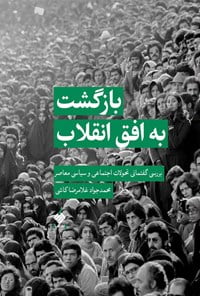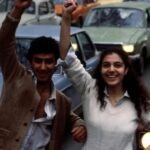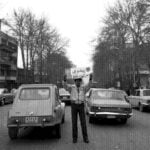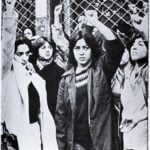
Return to the Horizon of the Revolution: A Discourse Analysis of the Contemporary Social and Political Transformations
Mohammad Javad Gholamreza Kashi
Āzmā Publishing House, Tehran, 2020
Mohammad Javad Gholamreza Kashi is an associate professor at the Faculty of Law and Political Sciences of Allameh Tabatabai University in Tehran.
The title of the book Return to the Horizon of the Revolution is based on a transliteration of a one-day workshop in Iran held by the author in 2015. The book comprises five chapters: Society and Language, Different Levels of Language-Politics Connections, Moving from a Tent World to a Linear World, What Has Happened to Political Islam, and Return to the Horizon of the Revolution.
The first two chapters explore the author’s theoretical underpinning for a discursive political approach. The subsequent chapters delve into Iran’s political history, spanning from the period before the 1979 Iran Revolution to the present day, ultimately leading Kashi to characterize Iran’s current state as grappling with a political crisis. He argues this crisis is characterised by severe conflicts between the state and society resulting from an increasingly polarised society and the state’s increasing inclination to build a homogenous society and strip off its plurality.
Kashi’s concerns about the marginalization of religion in our lifeworld in Iran are manifested throughout the book as he advises us to return to the glorious days of the 1979 Revolution and reinvent them rather than wait for a bleak future to come.
In this book, Kashi aims to provide a discourse analysis of the recent social and political transformations in Iran. The author commences by providing a definition of the term “discourse” and contends that this concept mirrors the connection between language and power. (p. 9) He explains using this methodology for political analysis means focusing on a network of concepts, signifiers, and rites, rather than relying on social class or state formation process, to grasp the discursive constructs that flow among different social groups, leading to the formation of the regimes of truth, reshape the power relations, and occasionally used to mobilize the social forces for a political change.
In his earlier book (1379/2000), The Magic of Discourse (Jāduy-e Goftār), Kashi explores how specific shifts in the Reformists’ political discourse, particularly in the aftermath of the Iran-Iraq war (1980-88) helped them to win the 1997 presidential election. Widely acclaimed for its innovative methodology, The Magic of Discourse was among the first books to apply critical discourse analysis to study politics in Iran. He explained how the two opposing discourses shaped Iranian politics in 1997: the discourse of Velāyat-e Faghih (believing in the Supreme Leader’s absolute power) represented by the conservative candidate Nategh Nouri, and a new discourse of democracy, the rule of law, and civil society, formulated and represented by Mohamad Khatami. The new discourse disrupted the hegemonic position of the discourse architected by Ayatollah Khomeini by opening the way for marginalized discourses to return to the scene.
Kashi carried on with his research project of discourse analysis of the politics in Iran by writing several articles and commentaries and publishing a new book in 2006, The Order and Transformation of Democratic Discourse in Iran (Nazm-e Goftār va Farāyand-e Tahavvoleh Goftāry-e Democrācy dar Irān) to discuss the political developments of the Reformism era. His new book, papers, and speeches indicate that he succeeded in enriching his arguments through time.
However, in Return to the Horizon of the Revolution, Kashi has broadened the scope of his research both in time and scope by studying all current political discourses in Iran, including nationalism, socialism, progressivism, and Iranshahri[1]Iranshahri is a theoretical stand that claims Iran has a unique historical trajectory, notably its ancient state and nation. According to this theory, the national state emerged in Iran under the … Continue reading, in addition to democracy and Islam. He extends the time frame of his study to the present time and claims he has explored novel connections between language and politics, which are essential to understanding his recent work.
In the subsequent analysis, I delve into Kashi’s argumentative construction across diverse domains. The reader must approach the book as an introductory exploration of Kashi’s analytical and historical breadth. Otherwise, the work might fall short of the heightened expectations set in the initial chapter. Some sections exhibit fragmentation and underdevelopment, while others lack the depth of analysis. These deficiencies might find justification in a workshop setting but are less acceptable for a book. To introduce the book, I review each chapter’s main argument first and then discuss my critical points.
Dissemination of Religious Discourse
The first two chapters lay out the book’s theoretical framework and explain how language forms the foundation of social life through naming objects and telling stories or making mythology, which constructs the “otherness”, among other things. Kashi argues that language and politics are interconnected at three levels: the first level is the visible layer of the language, which deals with concrete issues and problems; the second level is the deep layer of political groups’ ideologies; and the third level or the deepest layer of connection deals with the broader historical experience of a society which resides in deep layers of social imaginary and routines of collective life. (p. 14-31). Kashi frequently refers to this three-level relationship throughout the book, but his arguments do not go beyond these references to build new analytical theses or arguments. Furthermore, it soon becomes apparent that he does not give the reader a linguistic and discourse analysis of the politics in Iran, with average standards.
His focus on Iran’s socio-historical context starts in the third chapter, where he begins with the 1906 Constitutional Revolution and the beginning of modernity in Iran and explains how it changed the existing discourses in Iran at the level of the political groups’ ideology. He traces the changes spanning seventy years, leading up to the pivotal moment of the 1979 Revolution, where Islam underwent a transformative evolution, becoming the ideological cornerstone of the Revolution. Furthermore, his analysis extends beyond the post-revolutionary era, the 1990s reform period, and subsequent developments. Remarkably, this extensive historical period is condensed into a mere 15-page chapter.
The main arguments of the chapter could be summarized as follows: first, Iranian’s encounter with modernity has transformed their world from a single-source, centralized tent-like reality in which God was the only signifier that descended from above to give meaning to every aspect of Iranian’s lives to a multi-centred mosaic-like world with different meaning-construction sources. Second, the two deeply ingrained discursive sources in Iran’s tradition, namely Islam and Iranshahri ideologies, are divided in this new world. The four additional discursive sources of nationalism, democracy, modernity, and progressivism are added to this new multi-centred world. According to Kashi, these four discursive sources are imported from the West and thus have no bearing on Iranian’s lifeworld. These sources are still weak and marginal because they have not produced the material to change Iran’s social and political imaginaries. (p. 35-38)
Kashi’s argument is that the new discursive sources, including democracy, nationalism and progress, have remained unlocalized within our cultural context for over a century. Iran has been harshly affected by modernity since the Constitution Revolution and the rise of the technocrats in a hurry to apply modern processes, and society had no way to turn back. Reza Shah, for example, chose to use discourses of nationalism, progressivism, and Iranshahri and ignored Islam, socialism and democracy in establishing his project of the nation-state. What Reza Shah ignored became grounds for growing opposition against Pahlavi, especially during the Pahlavi II when the political climate leaned toward Iranshahri discourse and paved the way for the opposition discourses to grow more. (p. 39-40)
To support his central argument in the book, which posits that Islam played a crucial role in the years leading up to the 1979 Revolution, Kashi explains how the Pahlavi era stripped the political discursive sphere of its fundamental essence. He asserts that in the transformative space of the 1960s and 1970s, “astonishingly, we suddenly witness” a societal shift in Iran. Religion, which Reza Shah marginalized in the political realm and was merely “a place of refuge for fugitives of uneven modernity of Pahlavi era,” permeated the people’s political consciousness, expanding its influence in society and culture. (p. 40-42)
However, Kashi’s argument about the political discourses being changed in Iran is not supported empirically. Primarily, He references a recently distinguished survey report on Iranian attitudes conducted by Ali Asadi and Majid Tehranian in 1974/1353 for Iran’s Radio and TV organization. According to Kashi, this report exemplifies the expansion of religious inclinations in pre-revolutionary Iran. He believes that contrary to prevalent assumptions, the report suggests a direct correlation between the proliferation of religious tendencies and educational attainment in Iran before the Revolution.
Regardless of the accuracy of Kashi’s assessment of Asadi and Tehranian’s 1974 survey, it remains unclear why he chooses to employ survey data to bolster his arguments instead of employing the method of discourse analysis. This decision is puzzling given Kashi’s consistent emphasis on the advantages of linguistic analysis in political discourse, highlighting its ability to “take the pulse of society.” (p. 10–11)
Kashi goes too far in arguing that Iran’s late 1970s saw the resurgence of Islamic discourse in the public sphere, based on the survey’s small account of data. He writes, ”Asadi’s report implies that a new discursive system was emerging, which religion served as its most potent cornerstone, and could subsume all the other discursive systems and signifiers.” (p. 42) His overall gravitation toward Islam extends to leftist activists and secular intellectuals. He ignores multiple factors that contributed to the strengthening of ties between certain leftist and Islamist groups while other groups were growing apart. He writes: “The left gradually changed course and grew closer to religious groups.” He alludes to the famous story of Khosrow Golsorkhi and draws on to the case of this prominent Iranian communist activist who expressed his admiration for Islamic symbols of resistance in his military court hearing. “He abruptly spoke about Imam Ali,” writes Kashi. Even the Shah is among those who were affected by Islamic influence. Kashi notes that Mohammad Reza Shah travelled to Mashhad as a pilgrim because he felt he was ”gradually losing his power.” According to Kashi, the Queen, Farah Diba, also worked to link religion with Pahlavi’s ideologies through her collaboration with Henry Corbin[2]French philosopher and theologian Henry Corbin (1803–1978) taught Shiite and traditional Islamic philosophy at the University of Tehran for over thirty years. and Seyyed Hossein Nasr[3]Seyyed Hossein Nasr (1933) is an Iranian philosopher and theologian who was appointed a professor of philosophy and Islamic sciences at the University of Tehran. He held various academic positions … Continue reading, prominent scholars of traditional Islamic philosophy and theology teaching then at the University of Tehran. (p. 42)
Kashi’s attempt to connect his collection of the events and processes of the intellectual and political landscape during the last decades of Pahlavi rule (1960–1970s) to Islam and its spread as a discourse fails to come together. All political struggles and the regime’s responses to them seem to be reflecting the expanding Islamic discourse, including the various leftist groups, who all seem to be moving closer to the Islamic groups.
In Kashi’s historiography, Islam is presented as more than just one of the political discourses in the Pahlavi era, which competed with other ideologies such as leftist and nationalist discourses. Instead, it is portrayed as a comprehensive and inclusive framework, notable for its ability “to encompass all other ideologies under its umbrella, except the Iranshahri theory” (p. 43). From his perspective, Islam not only had the potential to foster socialism, modernity, and progress alongside democracy, but it also conferred legitimacy upon all these ideologies on the eve of the 1979 revolution:
It is apparent that, within that historical epoch, individuals were earnestly striving for the principles of democracy. Simultaneously, they maintained the conviction that Islam would infuse democracy with a spiritual essence. They envisaged Islam as a wellspring of spiritual potency, thereby imbuing democracy with profound significance. (p. 47)
Here, Kashi is referring to Ali Shariati, a prominent Islamic intellectual whose ideas continue to motivate a large number of reformist scholars in Iran: “He [Shariati] reinterpreted these various components [originating from other sources] in his religion-based discourse system so masterfully that we are still unable to abandon it.” (p. 45) Kashi adds that the re-emergence of religion was a ”global change” of the time that had also permeated the “European leftists”. (p. 46)
In Kashi’s analysis, the dominant religious spirit prevailing in Iran during the 1960s and 1970s gradually transforms into a supra-historical essence, displacing long-standing normative and cultural structures. This includes the conduct of Iranian communists, who, according to Kashi, no longer resembled the Russian “Vodka drinkers” (p.46). Due to the religious spirit of the times, the Islamic discourse dominated all spheres of political and intellectual life in 1979 Iran, and all concepts were redefined in light of the religion, the prime signifier. Kashi explains:
Our society that [during the Pahlavi era] modelled itself on the nation-state paradigm required ideological organization and the relationship between language and power at the second level [meaning the ideological level]. When these ideological organizations break down, society becomes aimless, fragmented, and engulfed in collective fear and turmoil. (p. 52)
Kashi’s articulation of the discursive systems is unacceptable because he ignores the part that independent intellectuals and political activists- including those working with the government, played in shaping the political environment and discourses of the 1960s and 1970s. The argument on the hegemony of the Islamic discourse in 1970s Iran relies on a survey report, which needs careful reading and consultation with other sources. Kashi does not discuss the results of various studies on political discourses in pre-revolutionary Iran. These studies paint a more accurate picture of society than one that is “aimless, fragmented, and engulfed in collective fear and turmoil.” (cf. Amanat, 2017; Schayegh, 2009; Mirsepassi, 2019; Chehabi, 2012, 1999).
Kashi disregards the sources that politicized nonreligious people in the 1970s, including housewives, intellectuals, academics, teachers, workers, students, and non-Muslims who held anti-Shah and anti-monarchy sentiments. He describes how people turned to ”actual political energies” by religion and how people also made it possible for “religion to become political.” He focuses on this mutual relationship: “Religion had the chance to take on a political role. It also acted as the primary signifier for organizing the [Revolution’s] language (discourse).” (p. 47) While this account may explain how some religious people got involved in politics during the Revolution, it leaves out many other groups and different sources that inspired them to participate in the Revolution. The numerous documents attesting to the participation of different groups in the revolution could have motivated the author to look for other sources.
Looking Back at Reasons for Defeat
A critique analysis, or as he terms it, a “bitter narrative” of the changes in the Islamic Republic’s political system, follows Kashi’s sympathetic account of the 1979 Revolution. Chapter four explains how political Islam became ingrained in the structural framework of the system and how, as the system moves away from the horizon of the revolution, it loses the ”momentum” it once held as a counterweight to Western modernity. Referencing Michael Foucault, who famously testified that he was shocked and amazed by the momentum when he rushed to revolutionary Iran in 1978 to see and report the Revolution, is a very common way to explain this “momentum.” (p. 52) According to Kashi, the war with Iraq (1980–88) changed the rail and pushed the Islamic Republic away from its momentum: “Unfortunately, the Islamic Republic is inspired more by the legacy of the war discourse rather than the revolutionary discourse; this is the legacy of the war for Iran.” (p. 52)
The Islamic Republic abandoned the discourses of democracy and nationalism one by one as it moved in this direction; it replaced Islam with Shi’ism and began expelling Shiite figures from its inner circles [khody-hā]. (p. 71) The overwhelming plurality of the revolutionary moment was ignored, and the regime established a mass mobilizing apparatus to homogenize the society. The result was a “commodified, objectified, and populist religion” (p. 61) and a regime that takes pride in delivering security rather than freedom, justice and welfare. (p. 63)
As Kashi tries to figure out how the Revolution moved away from its horizon, he turns to conspiracy theories regarding “the colonial power of annihilation”. He claims that colonialism is shrewd in using circumstances to its advantage and seeks to separate religion from our lifeworld to serve its own interests:
We are all disturbed by how the [global capitalist] market’s alienating and dissolving power over culture has affected our current situation in Iran. It seems it has used religion as a tool of control, which is irritating but true; otherwise, they could not have separated religion from our world-life system. (p. 60-61)
He quickly clarifies that he means that religion is in great danger, not that it has been eliminated from our lifeworld; religion has continued to exist “because people have nowhere else to go.” It is like “a mother! She might occasionally lose her temper, but she is still your mother, and you don’t give up on her.” (p. 61)
Return to neo-Shariati Project
The book’s fifth and final chapter proposes a transformative change, a path to change by looking toward the past to the horizon of the Revolution. Kashi argues: “To be honest, you are not supposed to always look forward in politics.” (p. 67). Drawing inspiration from Kierkegaardian philosophy, he suggests that contemplating repetition becomes meaningful, particularly in the face of a disconcerting future landscape.[4]The concept of repetition has a Janus face in Kierkegaard’s philosophy. On the one hand, repetition is a religious category of transcendence. On the other hand, it connotes the banal monotony … Continue reading This concept mirrors an echo, a persistent hope for a new day. Analogous to lovers who continue writing letters to their beloved without expecting a response, Kashi employs the metaphor of writing “until he is alive,” harbouring the expectation that such persistence will eventually “open a door”. (p. 68)
The enigmatic nature of Kashi’s lover, or the “Horizon of the Revolution”, prompts contemplation. Is this the same as the neo-Shariati project, and Dr. Ali Shariati Cultural Foundation members refer to it as “Shariati’s unfinished project”? Kashi introduces this religious-political horizon by referring to its presence in Iranians’ historical imagination: “There is a ‘momentum’ in Iran’s political history which is still alive in our social imagination” (p. 68).
According to Kashi, this horizon exhibits two distinct features. Firstly, it was a multivocal pluralist system that, in contrast to the Islamic Republic’s strict interpretation of Islam, allowed for ”the individual and personal initiatives a live presence.” Secondly, “all the conceptual frameworks of the time benefited from a holistic view”, suggesting an engagement with concepts beyond Shiism, encompassing ideas like freedom and Islam. One example of such an overarching approach is provided by this quotation from Ayatollah Taleghani: “One could refer to any revolution worldwide that opposes tyranny, colonialism, and exploitation as an Islamic revolution!” (p. 69)
Kashi’s “Horizon of the Revolution” does not offer a breakthrough in Iranian politics. None of the significant problems raised by the Islamic Republic’s integration of religion and state are addressed by Taleghani’s concept of an “inclusive” Islam or the “multi-vocal” Islam that provided the framework for the reformist project. Taleghani’s remark was rhetorical and a fruitless attempt to define the Islamic revolution by ideas that had been formulated and expressed in other discourses. In light of this, it becomes essential to scrutinize how the neo-Shariati project upholds the inclusive rhetoric of revolutionary moments and multivocal Islam as a reference point for constructing a discourse in Iran’s political future, especially considering their gradual fading in the past few decades due to the prevalence of monolithic Islam in everyday experiences.
Indeed, The proposal to revert to the 1979 Islamic Revolution horizon, when considered alongside other suggestions, such as a return to the horizon of the Constitutional Revolution advocated by some in recent years, highlights a point of contention within the current social science episteme in Iran.[5]Look at the link below for an example of these conflicts: https://bit.ly/3Zh2hu6 It seems that the parties engaged in this dispute are unaware that the force presently advocating for freedom and justice in Iran likely opposes not the coordinates ascribed to them by the narrators of these frameworks but rather the underlying content proposed by each side for these frameworks. It appears that this force seeks to shape the content of the future independent of these prescribed frameworks. The nature of this alternative perspective remains to be seen.
Responding to a critique of his book on August 9, 2023, a few months after the emergence of the Woman, Life, Freedom movement in Iran, Kashi remarks, “Aspiring to return to the horizon of the revolutionary era a decade ago as a means of liberating oneself from the challenges of political life. Unfortunately, I perceive this prospect as implausible in today’s Iranian society. It appears to be too late. A generation that has entered the scene fundamentally delineates its boundaries from such a horizon” (Kashi, 2023/1402). While conveying a sense of regret, this statement reflects a scholarly acknowledgement of the need for a thoughtful reassessment of his earlier positions.
Bibliographie
- Kashi, Mohammad Javad Gholamreza. 1399/2020. Bāzghast be Ofogh-e Enghelāb: Barresy-e Goftmany-e Tahavvolat-e Ejtemā‘y va Siāsy-e Moāser [Return to the Horizon of the Revolution: A Discourse Analysis of the Contemporary Social and Political Transformations.] Āzmā Publishing House, Tehran, 2020
References
- Aghajari, Hashem, Ebrahim Tofiq, & Omid Maljoo. 1402/2023. “Constitutional or Post-Constitutional? Where Do We Stand?“ [Mashruteh yā Pasā-Mashruteh? Kojā Istādehim?]. E‘temād Newspaper, September 20, 2023. https://bit.ly/3Zh2hu6
- Asadi, Ali, & Majid Tehraniyan. 1395/2016. The Unheard Voice: Social-Cultural Attitudes and Imbalanced Development in Iran [Sedāiy keh Shenideh Nashod: Negareshhay-e Ejtemā‘y-Farhangy va Tose‘h’ Nāmotevāzen dar Irān.] Edited by A. Abdi & M. Goodarzi. Tehran: Ney
- Amanat, Abbas .2018. Iran: A Modern History. New Haven: Yale University Press
- Chehabi, Houchang E. 1990. Iranian Politics and Religious Modernism. Ithaca, NY: Cornell University Press
- Chehabi, Houchang E. 2012. “The Banning of the Veil and its Consequences,” in The Making of Modern Iran. Routledge, 193-210
- Kashi, Mohammad Javad Golamreza. 1379/2000. The Magic of Discourse: Cultural Mentality and Semantic System in the Second of Khordad Elections [Jāduy-e Goftār: Zehniyyateh Farhangy va Nezām-e Ma‘nāiy dar Entekhābāt-e Dovvom-e Khordād .] Tehran: Ayandeh-Puyān Institute
- Kashi, Mohammad Javad Golamreza. 1385/2006. The Order and Transformation of Democratic Discourse in Iran [Nazm-e Goftār va Farāyand-e Tahavvoleh Goftāry-e Democrācy dar Irān.] Tehran: Tarh-e No
- Kashi, Mohammad Javad Golamreza. 1402/2023. “A Critique of the Critique of Return to the Revolution” [Naghdy bar Naghd-e Bāzgasht be Ofogh-e Enghelāb.] KetābNiyuz Website https://bit.ly/3LGXlZZ
- Mirsepassi, Ali. 2019. Iran’s Quiet Revolution: The Downfall of the Pahlavi State. Cambridge, United Kingdom: Cambridge University Press
- Schayegh, Cyrus. 2009. Who Is Knowledgeable Is Strong: Science, Class, and the Formation of Modern Iranian Society, 1900-1950. Berkeley: University of California Press
Endnotes
| ↑1 | Iranshahri is a theoretical stand that claims Iran has a unique historical trajectory, notably its ancient state and nation. According to this theory, the national state emerged in Iran under the Sassanid dynasty (224-651 AD). Since then, diverse ethnicities and cultural communities in this land have come together under the banner of one nation-state, ensuring the historical continuity of “Iran” from pre-Islamic to the modern era. This perspective has garnered support in specific intellectual and elite circles since 1920. (For further details, cf. Mirsepassi 2019) |
|---|---|
| ↑2 | French philosopher and theologian Henry Corbin (1803–1978) taught Shiite and traditional Islamic philosophy at the University of Tehran for over thirty years. |
| ↑3 | Seyyed Hossein Nasr (1933) is an Iranian philosopher and theologian who was appointed a professor of philosophy and Islamic sciences at the University of Tehran. He held various academic positions in Iran and established the Imperial Iranian Academy of Philosophy. He was assigned as the Queen’s special bureau director in 1978. |
| ↑4 | The concept of repetition has a Janus face in Kierkegaard’s philosophy. On the one hand, repetition is a religious category of transcendence. On the other hand, it connotes the banal monotony of earthly life. |
| ↑5 | Look at the link below for an example of these conflicts: https://bit.ly/3Zh2hu6 |








Comments are closed.